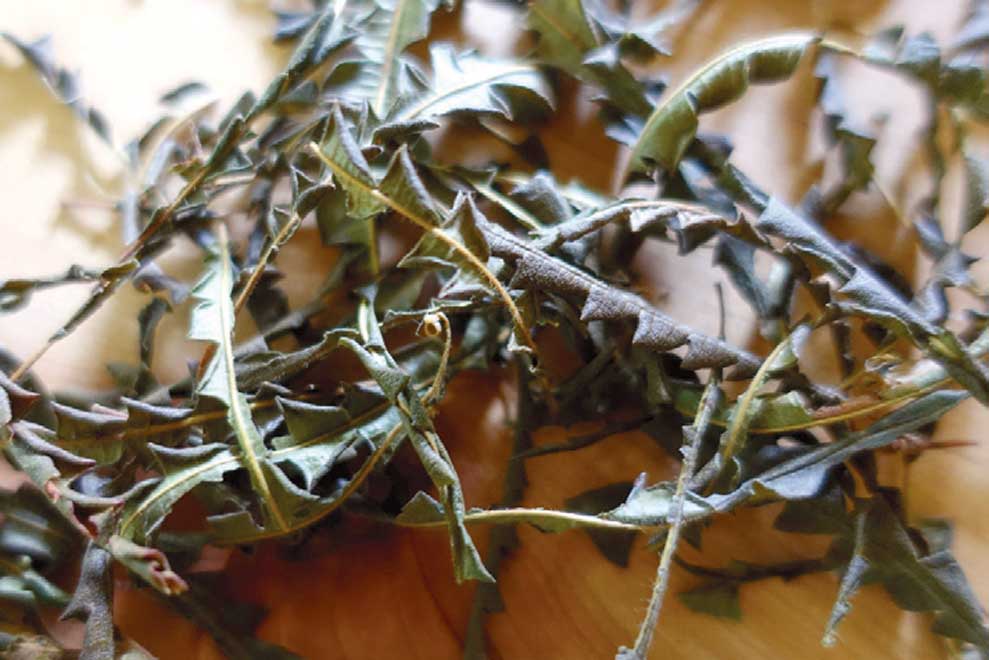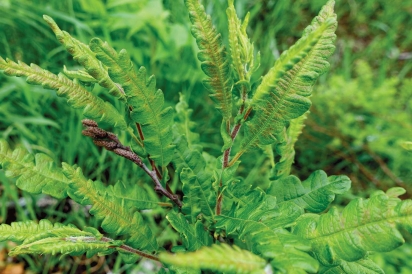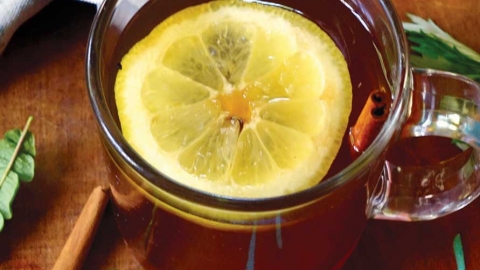Eating Wild: What’s in a Name? Sweetfern
The names we give plants are sometimes straightforward and helpful, letting you know exactly what you should expect — think white clover, blueberry, or, as I’ve written about before in this series, deadly nightshade. Other times, they are misleading or confusing, providing either unclear or inaccurate information that does no one any favors — lamb’s quarters is one I get questions about often. Sweetfern, one of my favorite fall foraging finds, lands much closer to the second camp. It is not particularly sweet. It is definitely not a fern. But, misnomer aside, once this aromatic plant gets on your radar, you aren’t likely to forget it.
For me, the smell of sweetfern (Latin name Comptonia peregrina) brings me back to coastal Maine, the place where I first happened upon this plant that has since become a foraging staple. Like all regular folks, I often road trip with a food dehydrator in the back of my car, ready to be plugged into a campground or rental cabin outlet so I can dry whatever wild food finds I might find in my travels. Mugwort and wild mint, stinging nettle and oyster mushrooms — they’ve all made their way into my cupboard via this route at one point or another. And several years ago, while staying in a small cabin in the section of northern Maine that is nearly Canada, the trusty dehydrator was full of sweetfern leaves, harvested from sprawling stands of bushes found along trails and roadsides. The warm smell of drying sweetfern filled the tiny kitchen, and each time my husband and I returned from hiking or canoeing we breathed in that distinct, welcoming scent. It is a fragrance that will forever remind me of that rustic two-room space.
So what, exactly, does sweetfern smell like? For someone who makes their living with words, I have a surprisingly hard time describing this one. It smells…cozy? Comforting? Familiar in a way I can’t exactly pin down. The closest I’ve been able to come to is that it smells vaguely like snickerdoodle cookies, warm from the oven, but with some fresh greenery and a bit of citrus mixed in. Or like a much, much milder version of cloves, a less spicy version of cinnamon, or a distant cousin of caramelized sugar. You might come across some of this plant, rub a leaf to release its unique fragrance, and think that every one of these descriptions is completely off base, but I’d still put my money on your reaction coming close to, “Oh, that’s lovely.”
While the “sweet” part of sweetfern refers to the plant’s aroma, the “fern” bit comes down to one of those “it sort of looks” naming conventions that frequently leads to botanical confusion. Asparagus fern suffers from this same issue, as does wood sorrel, neither of which fall into those plant categories. Though sweetfern is in the Myricaceae family — which includes bog myrtle, wax myrtle, and bayberry — to some, the plant’s long and narrow leaves somewhat resemble the finely divided leaf structure present in many ferns. But take a closer look and you will see that, unlike the delicate-stemmed fronds present in true ferns, sweetfern’s blade-like leathery leaves, which have large, rounded lobes lining the sides, grow individually in an alternate arrangement on woody stems that can reach several feet high. These leaves are generally 2-6 inches long, and very narrow, measuring under an inch wide. Sweetfern is a perennial shrub that grows well in sandy soil like that on Cape Cod and can frequently be found in stands of multiple plants along the sides of trails and around the edges of the forest. I have found bountiful patches of sweetfern while exploring the wooded areas all around the Northeast coast, and often smell the signature fragrance before I even see the plants.
Sweetfern’s leaves are the part of this shrub that we want to harvest, and, unlike many other hyper-seasonal harvest items, can be picked beginning in the spring, when the leaves are brighter green and a bit more tender, through the late fall, when they are darker green and tough. Harvest sweetfern’s leaves by picking some tips of branches where leaves are attached, and some of the larger leaves around the plants without taking too many from any one spot. If you find many plants growing together you can spread out your harvesting even more, but as long as you pick in moderation you shouldn’t worry about damaging these resilient plants. Once you harvest your leaves, they can be used fresh, or dry and store them for use throughout the year. While I dry my sweetfern leaves in a single layer in a dehydrator set to a low temperature — like in that Maine cabin years ago — the stems with leaves attached can also be bundled and hung in a shady spot away from humidity until they crack and crumble when rolled between your fingers. The preserved leaves can then be stored in an airtight container out of direct sunlight, and I have found that they retain their scent and flavor for up to a year.
As with many plants in foraging rotation, my first use for sweetfern leaves (fresh or dried) is in herbal tea infusions, either on their own or in blends. I think that they pair nicely with bee balm flowers, fennel seeds, mugwort, and nettle. Though some people use the fresh younger leaves as a chopped herb, I have found even the spring leaves are often too leathery for my taste, but this doesn’t stop them from being a versatile ingredient in savory recipes in my kitchen. I add sweetfern leaves to soups and stews while they cook and remove them before eating in the same way I would use bay leaves. My trusted wild-food resources also recommend stuffing fish and game with sweetfern leaves prior to cooking, and while I haven’t tried this method yet I am excited to give it a go this fishing season. Sweetfern would also make a delicious addition to an ice cream base or infused into a butter used to make desserts.
And there is, in my mind, no better way to take advantage of the warm and spicy qualities sweetfern brings to the table than in fall favorites like mulled apple cider, mulled wine, and spiced hot toddies. To make a mulling mix, combine a smattering of non-foraged ingredients like orange peel, cinnamon, cloves, nutmeg, ginger, allspice, star anise, and cardamom, and add fresh or dried foraged ingredients including sweetfern, mugwort, or wild bee balm leaves. To make mulled cider or wine, place a few tablespoons of your mix in a large mesh tea strainer or tied cheesecloth bundle, and steep in simmering cider or wine before serving warm. If a spiced hot toddy is what you’re after (as I so often am on chilly fall days), make a hot water infusion with some mulling mix, before adding black tea and letting it steep for 4-5 minutes. Strain everything from the infusion and add honey or maple syrup; lemon juice; and bourbon, whiskey or dark rum. It is the perfect drink to enjoy with friends after an autumnal walk in the woods, or on your own by a fireplace with a good book.
While sweetfern could certainly use a more accurate rebrand (spiceleaf, perhaps?), the plant itself is a pretty perfect addition to both your pantry and your favorite fall treats. As you take those fall walks around the Cape’s many beautiful wooded and coastal spots, keep your eyes peeled and your nose on alert for this hard-to-describe but easy-to-love plant.
NOTE: Always consult with trusted experts and refer to foraging books and field guides for 100% positive plant identification before consuming any wild plant. As with harvesting any wild plant, and particularly ones that grow in commonly-sprayed areas, take particular care to collect from spaces you know to be chemical-free. Never pick any wild plant from protected spaces. Integrate new foods into your diet in small quantities to gauge any dietary and allergy sensitivities, and consult with a doctor if you have any questions or concerns about specific health issues or medication interactions.







